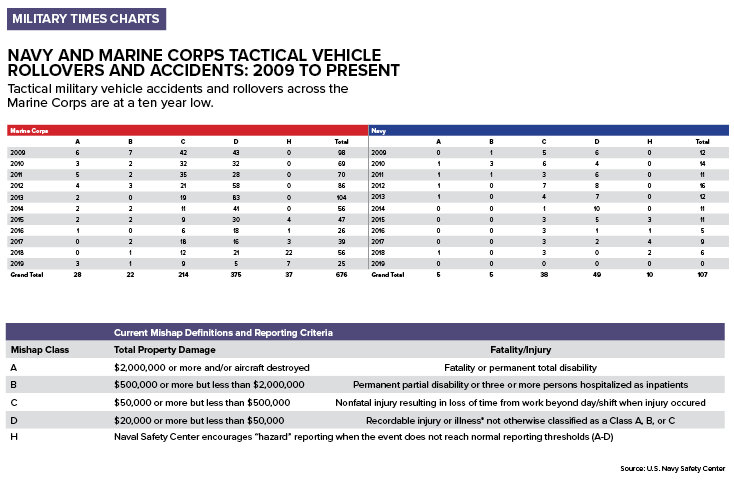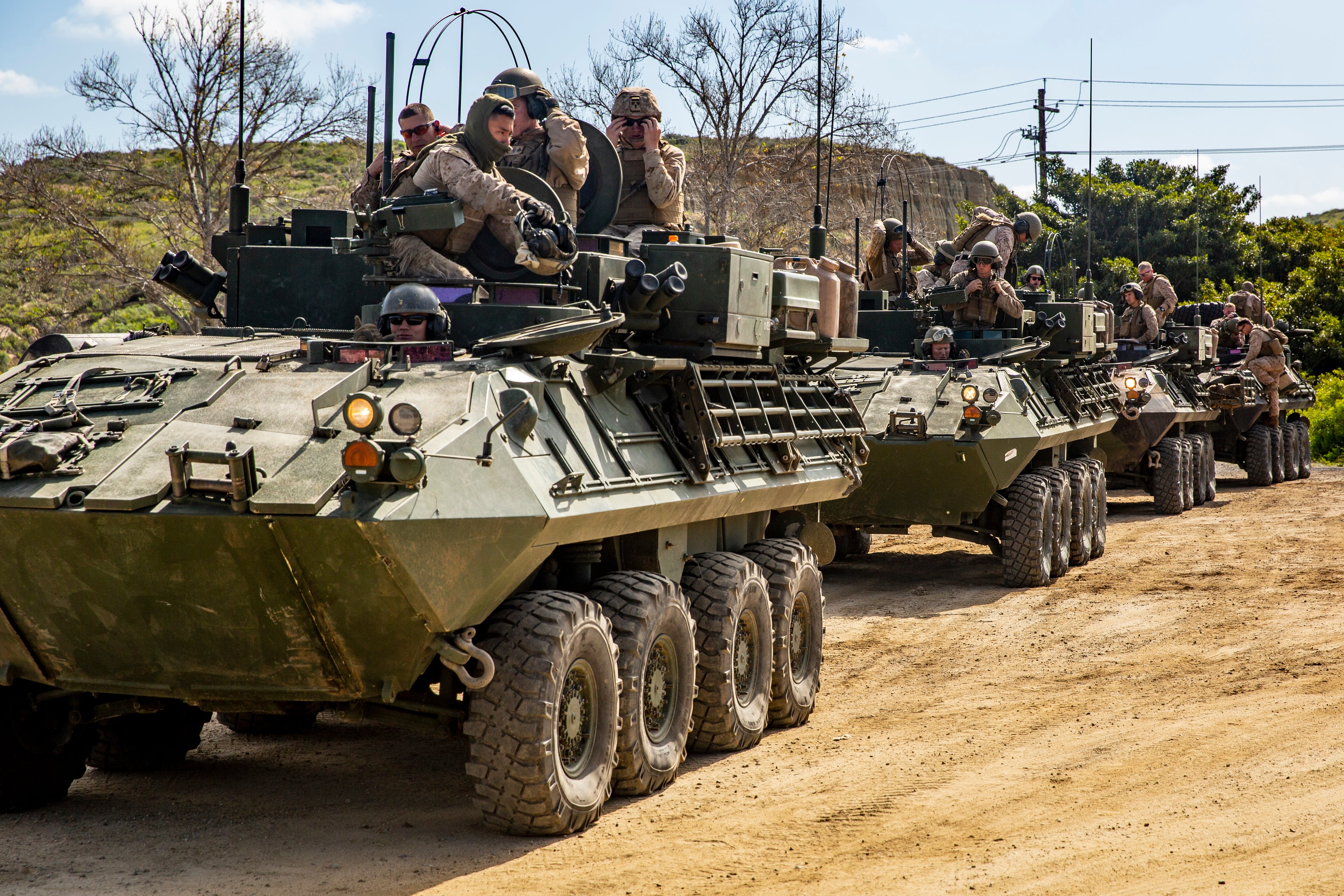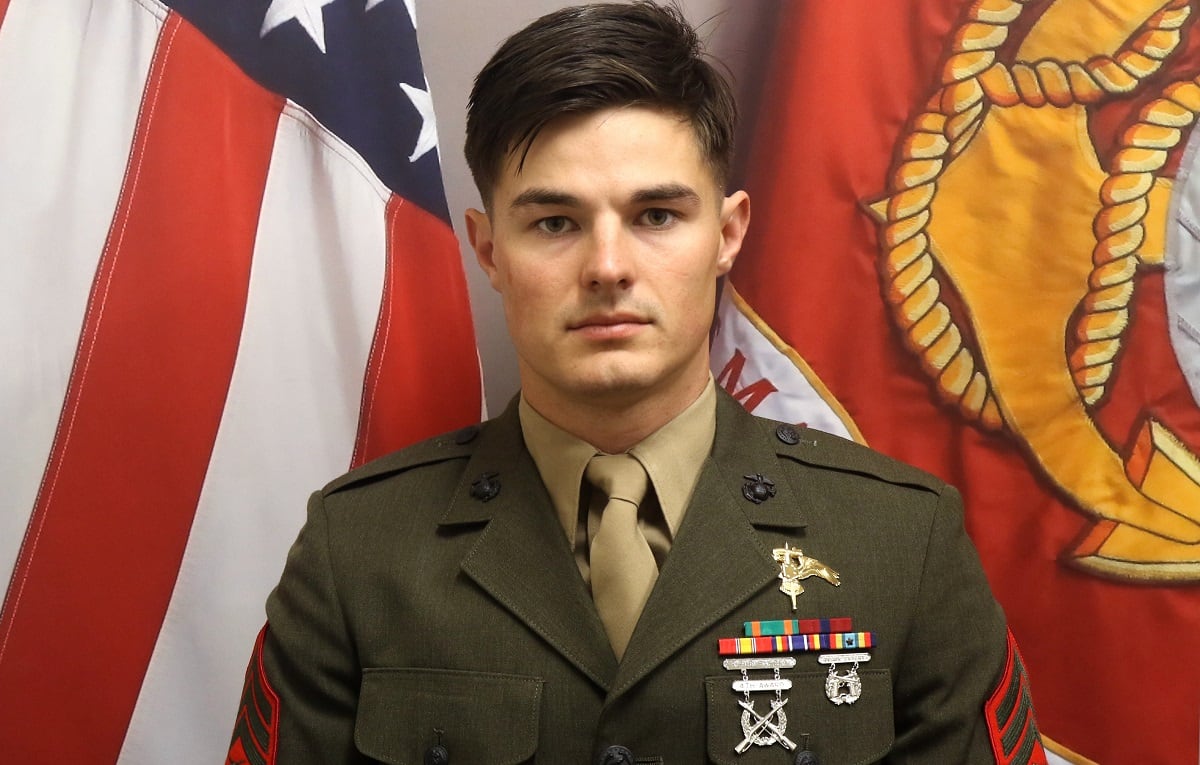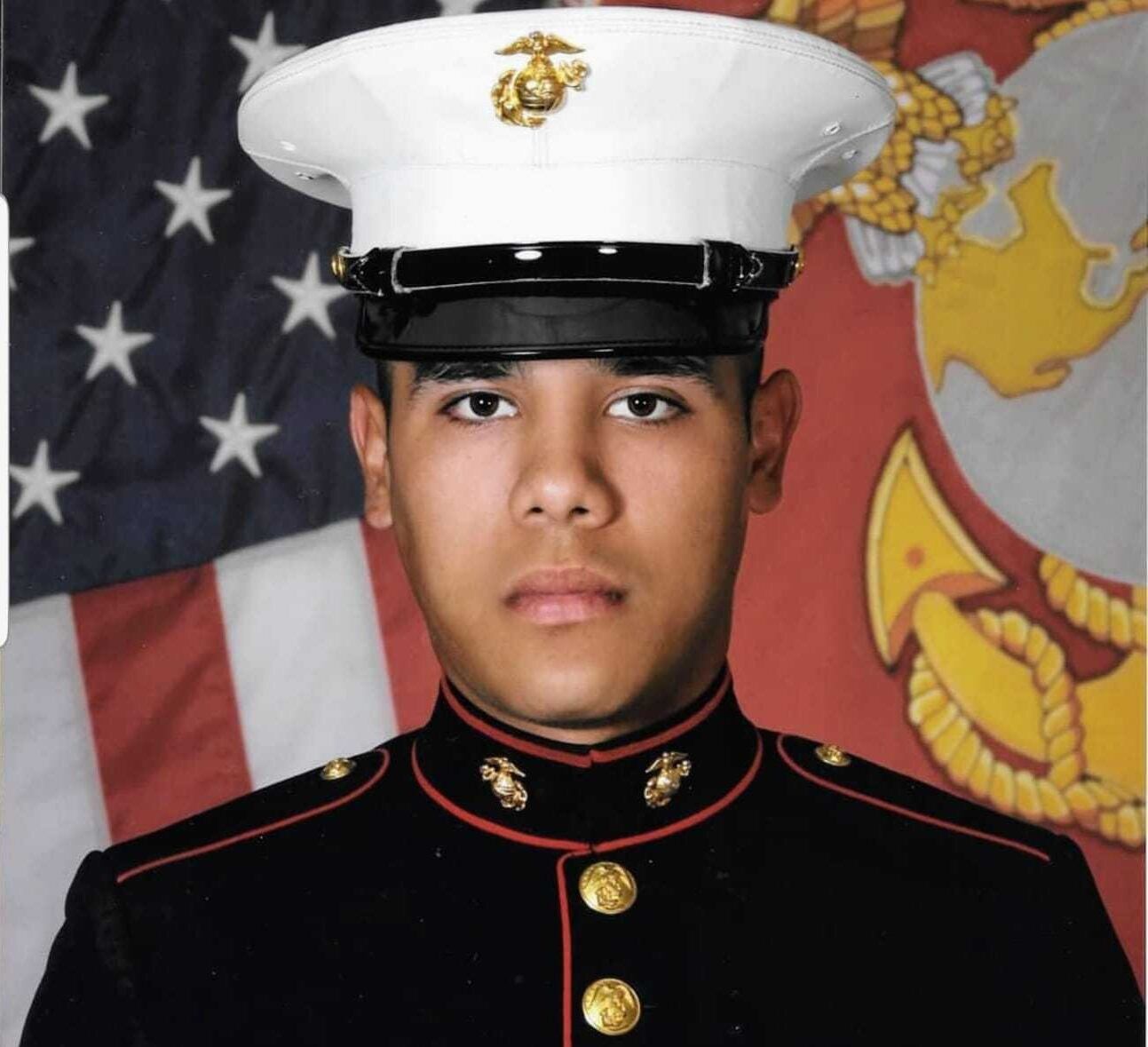With three deadly Marine Corps training accidents from April to May of this year, ground tactical vehicle accidents have been in the spotlight.
Marine Raider Staff Sgt. Joshua Braica lost his life April 14 after a Polaris MRZR rollover at Camp Pendleton, California.
Also at Camp Pendleton, California, light armored vehicle, or LAV, platoon commander 1st Lt. Hugh C. McDowell died May 9 following the rollover of his light armored reconnaissance vehicle. Six other Marines were treated for “non-serious injuries” from the accident, the Marine Corps said at the time.
Expeditionary airfield systems technician Lance Cpl. Hans Sandoval-Pereyra was with the Corps in Australia when he died May 28, following a Humvee training accident.
According to data provided by the Navy Safety Center, in the past seven years there has been a slight increase in the number of noncombat-related ground tactical vehicle accidents for what the Navy classifies as a Class A mishap. Those are the accidents that result in death, permanent total disability or $2 million plus in damages. These three accidents are in that category.
Overall, however, Marine and Navy noncombat-related tactical military vehicle accidents and rollovers are at a ten year low, and those mishaps also appear to be on a general decline, according to data provided by the Navy Safety Center.
The yearly tactical military vehicle accident figures are broken down by fiscal year and include Humvees, mine-resistant ambush protected vehicles and LAVs, among other tactical vehicles.
Whether the decline in these types of mishaps is a result of safer practices across the Corps or a reduced operations tempo from the Corps’ drawdown in Iraq and Afghanistan is unknown.

But these grieving families have questioned the Corps’ safety training procedures ― and now, they, along with some members of Congress, are questioning the Corps’ accuracy in reporting training safety mishap figures.
A congressional aide told Marine Corps Times on condition of anonymity that there is a question regarding whether the Corps is reporting all tactical ground vehicle accidents, even those that don’t result in injury or property damage.
Michael McDowell, the father of Marine Lt. McDowell, told Marine Corps Times he was “suspicious of what is not included, what is not reported, what criteria for reporting are set out, how wide or specific those criteria are, and so on.”
Monica Matoush, a spokeswoman for the House Armed Services Committee, said that the committee was looking into safety data provided by the Corps.
“We’ve received information from the USMC that indicates a decrease, but any time there is a mishap it warrants additional review," Matoush told Marine Corps Times in an emailed statement on July 17.
“We are still waiting for the accident investigation into the most recent LAV mishap and will determine next steps from an oversight perspective once we’ve reviewed the investigation report,” she said.
RELATED

Those incidents that don’t meet the threshold for a mishap class A through D are reported as “hazard” reporting, Stephanie Slater, a spokeswoman for the Navy Safety Center told Marine Corps Times in an emailed statement.
The Navy has a mishap threshold reporting criteria for government vehicle accidents that result in $5,000 or more in damages or result in injuries or death, Slater explained.
“But there are also events less than the $5,000 threshold that the command has elected to report as ‘hazards’ for no other reason than a desire to share with others,” she said.
“So, both the mandatory (those that meet the $5,000 threshold) and those that are voluntarily reported (below the $5,000 threshold) are listed as Class H events in the Naval Safety Center reporting system,” Slater said.
The Navy Safety Center has been encouraging reporting that doesn’t meet the standard threshold since 2015, Slater said.
RELATED

Michael McDowell said the Army and Marine Corps need a standardized reporting system. He met with House Armed Services Committee Readiness Subcommittee Chairman Rep. John Garamendi, D-Calif., in June to discuss how to prevent future training accidents.
“There are range safety problems, training of drivers standards, vehicle reliablity and maintenance issues," McDowell said. "Reforms need to be brought in now.”
In July, he penned an opinion piece in the Washington Post about his son’s LAV training accident. That article included a journal entry from his son dated Dec. 2, 2018 ― just more than five months before his death ― during a training exercise at Fort Irwin, California. The entry detailed what appeared to be frequently occurring LAV rollover accidents.
“Blue 1 Platoon had a rollover. No injuries. LAV dropped 8 feet onto turret, then onto side. 2 medical vics, 6 recovery vics going to site of rollover. Marines will be assessed and cared for. LAV will be left in place until daylight. Pictures will be taken as there will have to be an investigation. 7 Marines were on board. My job just got a lot more serious. Time to monitor the net for information requests. They’ll need a hoist. This isn’t the end of the world but we got really lucky. No injuries involved. . . . This is the second Charlie Company rollover in two months. One of the Marines was in both rollovers. . . . It’s a miracle no one was killed. Sounds like someone got fired. The tone in Chain of Command has sombered somewhat. This is a reminder that at any moment, through careless action, even in training, Marines can die. . . . all of Charlie Platoon’s commanders have now rolled over a vehicle.”
The 24-year-old first lieutenant was assigned to 1st Light Armored Reconnaissance Battalion, 1st Marine Division, headquarted at Camp Pendleton, California.
RELATED

Marine Corps Times reached out to the Navy Safety Center to confirm whether the incidents reflected in the journal entry were captured in the center’s reporting.
“A handful of minor government vehicle and tactical vehicle events were reported in California in December 2018, but none resemble the journal entry,” Slater said.
But Marine Corps Times has learned that the date of the journal entry may not directly coincide with the alleged rollovers at Fort Irwin, and that may be the reason the Navy Safety Center could not verify the entry in its reporting.
Marine Corps Times was unable to confirm if anyone was fired as a result of the training exercise rollover incidents at Fort Irwin.
“The Naval Safety Center diligently accounts what has been recorded, but mishap reporting relies on each individual unit’s compliance with Naval Instructions, which is not always complete, and which results in missing or incomplete data in the reporting system, especially for lower classes of events,” Slater said.
A former Marine LAV platoon commander and Iraq and Afghanistan veteran, who spoke to Marine Corps Times on condition of anonymity, said that LAV rollovers were not all too common. He remembers only one incident in Iraq that occurred at night because the driver couldn’t make out the edge of the road.
But the former LAV platoon commander did say the LAV has a high center of gravity and drivers and vehicle commanders “need to be mindful of angles and speeds while driving, to help avoid rollovers.”
Shawn Snow is the senior reporter for Marine Corps Times and a Marine Corps veteran.
Leo covers Congress, Veterans Affairs and the White House for Military Times. He has covered Washington, D.C. since 2004, focusing on military personnel and veterans policies. His work has earned numerous honors, including a 2009 Polk award, a 2010 National Headliner Award, the IAVA Leadership in Journalism award and the VFW News Media award.
